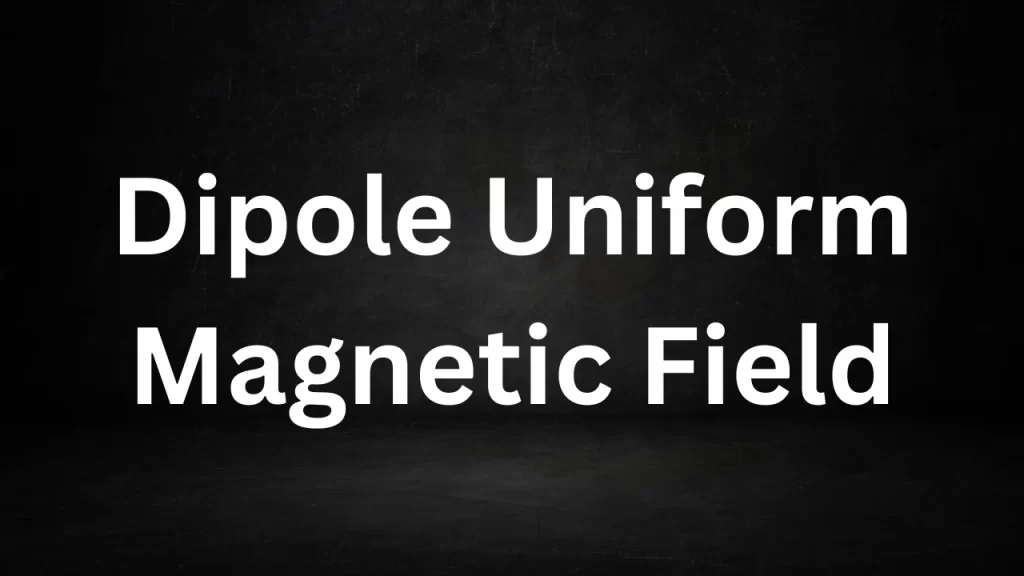Dipole Uniform Magnetic Field: The interaction between dipoles and magnetic fields is a fundamental concept in physics, particularly in the study of electromagnetism.
In this article, we will delve into the fascinating world of dipoles within a uniform magnetic field, exploring the principles, behaviors, and real-world applications of this phenomenon.

Dipole Uniform Magnetic Field
Understanding Dipoles
Before delving into the interaction between dipoles and magnetic fields, let’s clarify what a dipole is. In physics, a dipole refers to a pair of electric charges or magnetic poles with equal and opposite properties separated by some distance. Dipoles can be electric or magnetic.
Uniform Magnetic Fields
A uniform magnetic field, as the name suggests, is a magnetic field that has consistent strength and direction throughout a specified region of space. In such a field, magnetic lines of force run parallel and evenly spaced, creating a uniform environment.
Dipole in a Uniform Magnetic Field: The Torque Effect
When a magnetic dipole is placed within a uniform magnetic field, an interesting phenomenon occurs. The dipole experiences a rotational force known as torque. This torque is caused by the alignment of the dipole with the magnetic field, seeking the configuration of minimum potential energy.
Key points about this interaction:
- Alignment: The magnetic dipole will tend to align itself with the direction of the uniform magnetic fields. This alignment is analogous to a compass needle aligning with the Earth’s magnetic field.
- Torque: The torque applied to the dipole is proportional to the strength of the magnetic field, the dipole moment (a measure of the dipole’s strength), and the sine of the angle between the dipole moment and the magnetic field direction. The torque causes the dipole to rotate.
- Potential Energy: As the dipole aligns with the magnetic field, its potential energy decreases. When fully aligned, the potential energy is at a minimum.
Mathematical Representation
The torque (τ) experienced by a magnetic dipole in a uniform magnetic field is given by the formula:
τ = μBsinθ
Where:
- τ represents the torque.
- μ represents the dipole moment, a measure of the dipole’s strength.
- B represents the magnetic field strength.
- θ represents the angle between the dipole moment direction and the magnetic field direction.
Applications and Real-World Relevance
The interaction between dipoles and uniform magnetic fields finds applications in various real-world scenarios:
- Magnetic Compasses: Compass needles are essentially small magnetic dipoles that align with Earth’s magnetic field, aiding in navigation.
- MRI (Magnetic Resonance Imaging): In medical imaging, MRI machines use the principles of dipole interaction with magnetic fields to produce detailed images of the human body’s internal structures.
- Particle Accelerators: Magnetic dipoles are used in particle accelerators to steer and control the paths of charged particles.
- Electromagnetic Motors: The operation of electric motors involves the interaction of magnetic dipoles with magnetic fields, resulting in rotational motion.
In summary, the interaction between dipoles and uniform magnetic fields, characterized by the torque effect, is a fundamental concept in electromagnetism. This phenomenon underlies various technological applications, from compasses to medical imaging and particle accelerators, showcasing the profound impact of electromagnetic principles on our daily lives and scientific advancements.
Read More
- Light Filtering Polaroid Films Polarization
- Animals Biology Science Lion Zoology
- Difference Between Voltage And Current
- Difference Between Two Stroke And Four Stroke
- Difference Between Ac And Dc
Frequently Asked Questions (FAQs) Dipole Uniform Magnetic Field
1. What is a magnetic dipole in the context of a uniform magnetic field?
In physics, a magnetic dipole is a pair of magnetic poles with equal and opposite properties separated by some distance. When placed in a uniform magnetic field, it experiences a torque (rotational force) due to the alignment-seeking nature of magnetic dipoles.
2. How does a magnetic dipole align itself in a uniform magnetic field?
A magnetic dipole will tend to align itself with the direction of the uniform magnetic field. It aligns so that its magnetic moment (analogous to the dipole moment) points in the same direction as the magnetic field lines.
3. What causes the torque on a magnetic dipole in a uniform magnetic field?
The torque experienced by a magnetic dipole in a uniform magnetic field is due to the magnetic moment trying to align itself with the field direction. This torque is proportional to the strength of the magnetic field, the magnetic moment of the dipole, and the sine of the angle between the magnetic moment and the field direction.
4. What is the significance of potential energy in this interaction?
As the magnetic dipole aligns itself with the magnetic field, its potential energy decreases. When fully aligned, the potential energy reaches a minimum. This is a fundamental concept in understanding the stability of the dipole in the field.
5. How is the torque on a magnetic dipole mathematically represented?
The torque (τ) on a magnetic dipole in a uniform magnetic field is given by the formula τ = μBsinθ, where:
- τ represents the torque.
- μ represents the magnetic moment (dipole moment).
- B represents the magnetic field strength.
- θ represents the angle between the magnetic moment direction and the magnetic field direction.
